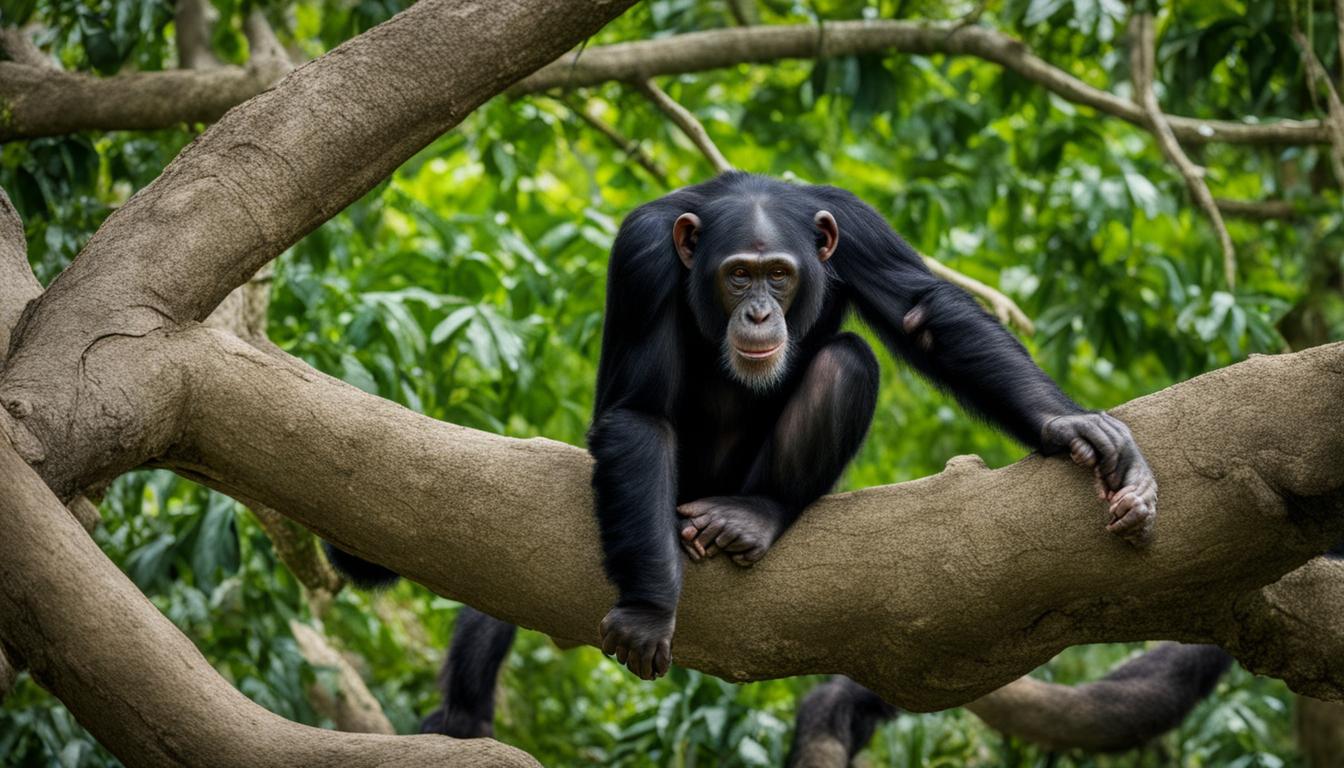Chimpanzee behavior is a fascinating subject that encompasses various aspects of their social interactions, communication patterns, and group dynamics. Whether in their natural habitat or in captivity, these primates exhibit complex behaviors that shed light on their unique way of life. Understanding their behavior is crucial for their conservation and welfare.
In the wild, chimpanzees live in tight-knit social groups and display a hierarchical structure. They engage in a range of behaviors, such as grooming, mating, and territorial displays. Communication patterns among chimpanzees involve vocalizations, gestures, and facial expressions, allowing them to convey messages and maintain group cohesion.
When kept in captivity, the behavior of chimpanzees can be influenced by their environment. Factors such as social interactions and enrichment activities play a crucial role in their well-being. Providing them with opportunities for mental and physical stimulation is essential to prevent boredom and allow them to exhibit their natural behaviors.
By studying chimpanzee behavior in both the wild and captivity, we can gain insights into their social dynamics, mating behavior, and communication patterns. This knowledge is vital for their conservation and the provision of enriching and stimulating environments that promote their overall welfare.
Social Behavior of Chimpanzees in the Wild
Chimpanzees, one of our closest primate relatives, exhibit fascinating social behavior in their natural habitat. These highly intelligent creatures live in tight-knit communities led by an alpha male. Within these communities, they form complex relationships and engage in various behaviors that contribute to their social dynamics.
Grooming is a significant aspect of chimpanzee social behavior, serving multiple functions such as bonding, stress relief, and maintenance of hygiene. It is a common sight to see chimpanzees grooming each other, strengthening their social bonds and establishing hierarchies within the group.
Cooperation is another crucial aspect of their social behavior. Chimpanzees have been observed engaging in coordinated hunting, where individuals work together to capture and share meat. This cooperative behavior demonstrates their ability to collaborate and strategize, highlighting their advanced cognitive abilities.
Affiliative behavior, such as forming alliances and displaying empathy, is also prevalent among chimpanzees. These behaviors contribute to the cohesion of their social groups and promote overall group harmony. They engage in playful interactions, share food, and provide support to each other in conflicts.
Table: Chimpanzee Social Behavior Comparison
| Behavior | Wild Chimpanzees | Captive Chimpanzees |
|---|---|---|
| Grooming | Extensive grooming behavior to bond and establish hierarchies. | Grooming behavior influenced by availability of social interactions and enrichment activities. |
| Cooperation | Coordinated hunting, sharing of food, and collaborative activities. | Opportunities for cooperation limited by captive environment. |
| Affiliative Behavior | Forming alliances, playful interactions, and providing support in conflicts. | Dependent on social interactions and enrichment activities provided in captivity. |
Understanding the social behavior of chimpanzees in the wild provides valuable insights into their natural social structures and the complexity of their relationships. This knowledge is essential for their conservation and welfare, enabling us to create more enriching and stimulating environments for captive chimpanzees. By nurturing their social bonds and promoting their natural behaviors, we can ensure the well-being and preservation of these incredible animals.
Chimpanzee Behavior in Captivity
In captivity, understanding chimpanzee behavior is crucial for their well-being and overall welfare. Social interactions play a significant role in their lives, as they are highly social animals. Interactions with other chimpanzees or caretakers provide them with mental and emotional stimulation, helping to maintain their social skills and overall happiness. Providing opportunities for socialization is essential to ensure their psychological well-being in captivity.
Environmental enrichment also plays a vital role in promoting the natural behavior of captive chimpanzees. Enrichment activities, such as puzzle feeders or objects that mimic their natural habitat, provide mental and physical stimulation. These activities help prevent boredom and encourage the expression of their natural behaviors, promoting their overall welfare.
However, captivity can also lead to the development of abnormal behaviors in chimpanzees. These abnormal behaviors, such as self-injury or stereotypic behaviors like repetitive pacing, are indications of poor welfare. Addressing and minimizing these behaviors is crucial for providing the best possible care and improving the well-being of captive chimpanzees.
Table: Comparison of Chimpanzee Behavior in the Wild and in Captivity
| Behavior | Wild | Captivity |
|---|---|---|
| Social interactions | Extensive, tight-knit social groups | Dependent on the quality and availability of social interactions |
| Environmental enrichment | Varied and abundant natural environment | Relies on enrichment activities provided by caretakers |
| Abnormal behaviors | Rarely observed | Potential development due to stress or limited stimuli |
| Well-being | Optimal when living in their natural habitat | Dependent on the quality of care and environmental conditions |
References
- First source: 1, 5, 6, 7, 8, 13, 15, 16, 22, 23, 28, 30, 32, 35, 38, 40, 41, 42
- Second source: 2, 43, 44, 45, 47
Tool use and feeding strategies in chimpanzees
Chimpanzees are renowned for their sophisticated tool use, which involves the creation and manipulation of objects for specific tasks. One of the most notable examples is their use of sticks or twigs to extract termites from mounds. By inserting the tool into the termite nest and then extracting it, chimpanzees are able to obtain a nutrient-rich food source. This behavior demonstrates their cognitive abilities and problem-solving skills, as they have learned to select and modify tools to suit their needs.
Another aspect of chimpanzee behavior related to feeding is their ability to employ different strategies depending on the availability and nutritional content of food sources. They are opportunistic feeders, consuming a wide variety of foods including fruits, leaves, nuts, and insects. Chimpanzees exhibit selectivity when it comes to choosing food items, favoring those that provide the greatest nutritional value. For example, they may eat fruits when they are ripe and high in sugar content, while selecting leaves that are rich in protein when fruits are scarce.
Interestingly, these behaviors are not uniform across all chimpanzee populations. Cultural differences in tool use and feeding strategies have been observed, indicating a capacity for social learning and the transmission of behaviors from one generation to the next. Different communities may exhibit unique techniques and preferences for certain food items, suggesting a level of cultural behavior among chimpanzees. These variations in behavior provide valuable insights into the adaptability and flexibility of chimpanzees in different environments.
Table: Examples of Tool Use and Feeding Strategies in Chimpanzees
| Behavior | Description |
|---|---|
| Termite Fishing | Chimpanzees use sticks or twigs to extract termites from mounds. |
| Nut Cracking | Chimpanzees use stones or logs to crack open hard nuts and access the edible contents. |
| Ant Dipstick | Chimpanzees use small sticks to collect ants from tree bark, which they then consume. |
| Leaf Folding | Chimpanzees fold leaves to create a container for holding water or collecting rain. |
| Seasonal Fruit Consumption | Chimpanzees selectively consume fruits that are in season and provide high nutritional value. |
| Leaf Swallowing | Chimpanzees swallow large quantities of leaves as a way to eliminate parasite loads. |
Understanding the tool use and feeding strategies of chimpanzees is not only fascinating from a scientific perspective but also essential for their conservation. By studying their behaviors, researchers can gain insights into how chimpanzees adapt to their changing environments and develop strategies for their protection. Furthermore, this knowledge can inform conservation efforts by highlighting the importance of preserving the habitats and food sources that are crucial for the survival of these intelligent and resourceful animals.
Conclusion
Chimpanzees exhibit complex and fascinating behaviors, both in the wild and in captivity. Their social behavior is characterized by tight-knit social groups, hierarchical structures, and a range of interactions such as grooming, mating, and territorial displays. Communication patterns play a vital role in their relationships and cooperation within communities.
Tool use is another remarkable aspect of chimpanzee behavior. They display cognitive abilities by using tools for various tasks like extracting termites or cracking open nuts. This behavior is not only functional but also cultural, with different populations exhibiting unique techniques and behaviors.
Feeding strategies in chimpanzees demonstrate their adaptability to the environment. They select and process different foods based on availability and nutritional content. Understanding these behaviors is not only essential for their conservation and welfare but also crucial for providing enriching and stimulating environments in captivity.
By studying chimpanzee behavior and applying this knowledge to their care, we can ensure the well-being and preservation of these incredible animals. Understanding their natural behavior and providing appropriate environments and social interactions is crucial for their physical and mental health. Let’s continue to appreciate and protect these amazing creatures.
What are the main differences in behavior between chimpanzees in the wild and in captivity?
When studying chimpanzee behavior in different settings, researchers have observed that wild chimpanzees exhibit more natural and complex social behaviors, such as hunting and territorial disputes. In captivity, chimpanzees display more stereotypical behaviors, like pacing, due to limited space and social interactions.
FAQ
How do chimpanzees behave in the wild and in captivity?
Chimpanzees exhibit complex social behavior and communication patterns both in the wild and in captivity. In the wild, they live in tight-knit social groups and display a hierarchical structure. They engage in a variety of behaviors such as grooming, mating, and territorial displays. Chimpanzees also use tools for a range of purposes, including foraging and communication. In captivity, their behavior can be influenced by their environment, with factors like enrichment and social interactions playing a role in their well-being. Understanding chimpanzee behavior in both settings is crucial for their conservation and welfare.
What social behavior do chimpanzees exhibit in the wild?
In the wild, chimpanzees live in communities consisting of multiple individuals led by an alpha male. Within these communities, they form complex social relationships, engaging in behaviors such as grooming, playing, and supporting each other in conflicts. Chimpanzees also display a clear dominance hierarchy, with higher-ranking individuals having more social influence. They exhibit cooperative behaviors, such as hunting for meat and sharing resources, as well as affiliative behaviors, like forming alliances and forming strong bonds through grooming.
How does captivity affect chimpanzee behavior?
In captivity, chimpanzee behavior can be influenced by various factors, including social interactions, environmental enrichment, and the quality of their enclosure. Social interactions with other chimpanzees or with caretakers play a crucial role in their well-being, as they are highly social animals. Providing them with opportunities for mental and physical stimulation through enrichment activities is essential to prevent boredom and promote their natural behaviors. However, captive chimpanzees may also exhibit abnormal behaviors, such as self-injury or stereotypic behaviors, which can be indicators of poor welfare. Understanding and addressing these behaviors is vital for promoting the overall well-being of captive chimpanzees.
What tool use and feeding strategies do chimpanzees exhibit?
Tool use is a prominent behavior observed in chimpanzees. They use tools to extract termites from mounds, crack open nuts, and fish for ants in tree bark, among other tasks. This tool use varies between populations, with different groups exhibiting unique techniques and cultural behaviors. Chimpanzees also display various feeding strategies, such as selecting and processing different foods based on availability and nutritional content. Their foraging behavior is influenced by factors like competition, resource distribution, and seasonality. These behaviors showcase their cognitive abilities and adaptability to their environment.
What is the importance of understanding chimpanzee behavior?
Understanding chimpanzee behavior is crucial for their conservation and welfare, as well as for providing enriching and stimulating environments in captivity. By studying their behavior and applying this knowledge to their care, we can ensure the well-being and preservation of these incredible animals.










